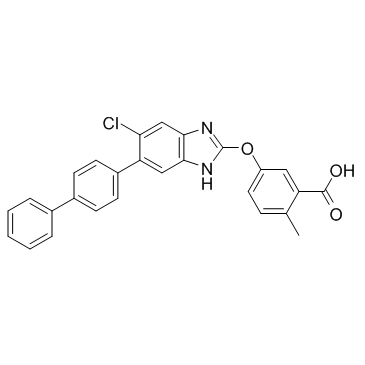| Description |
MK-3903 is a potent and selective AMP-activated protein kinase (AMPK) activator with an EC50 of 8 nM.
|
| Related Catalog |
|
| Target |
AMPK:8 nM (EC50)
|
| In Vitro |
MK-3903 (compound 42) is a potent and selective AMP-activated protein kinase (AMPK) activator with an EC50 of 8 nM. MK-3903 activates 10 of the 12 phosphorylated AMPK (pAMPK) complexes with EC50 values in the range of 8 to 40 nM and maximal activation >50%. MK-3903 partially activates pAMPK5 (36% max) and it does not activate pAMPK6. MK-3903 demonstrates low permeability (Papp=6×10-6 cm/s) in LLC-PK1 cells42 and is a substrate of human liver uptake transporters OATP1B1 and OATP1B3 (organic anion transporter proteins). Results show that MK-3903 binds moderately to the prostanoid DP2 (CRTH2) receptor (binding IC50=1.8 μM) but not in the presence of 10% human serum (binding IC50>86 μM)[1].
|
| In Vivo |
The pharmacokinetics of MK-3903 (compound 42) in C57BL/6 mice, Sprague to Dawley rats, and beagle dogs are characterized by moderate systemic plasma clearance (5.0 to13 mL/min/kg), a volume of distribution at steady state of 0.6 to 1.1 L/kg, and a terminal halflife of ~2h. Acute oral administration of MK-3903 (3, 10, and 30 mg/kg) to high-fructose fed db/+ mice results in significant inhibition of hepatic fatty acid synthesis (FAS) for all three doses[1].
|
| Kinase Assay |
The enzymatic reaction is performed. Briefly, the AMPK complex of interest is appropriately diluted in AMPK reaction buffer and incubated at room temperature for 30 min to yield pAMPK. Then, MK-3903 (compound 42) and pAMPK are pre-incubated by adding appropriately diluted MK-3903 in DMSO (1.2 μL total) to the reaction buffer containing pAMPK (15 μL per well), the plate is vortexed briefly and then incubated at room temperature for 30 min. The plate is sealed and incubated at room temperature for 60 min, at which time the reaction is stopped by the addition of quench buffer. EC50s and %activation parameters are calculated from %product vs. activator concentration plots[1].
|
| Animal Admin |
DIO mice at 17 weeks of age are used in this study. Mice are conditioned to dosing with vehicle (5% Tween 80, 0.25% methylcellulose, 0.02% SDS) at 5 mL/kg BID for 5 days. At that time, mice are bled, glucose and insulin measured and the animals sorted into treatment groups based on glucose, insulin and body weight. Each group of animals receives administration of MK-3903 (compound 42) in vehicle at 3 mg/kg, 10 mg/kg, 30 mg/kg, or vehicle alone for 12-day BID. Another group of mice receiving MK-3903 with vehicle at 30 mg/kg for 12-day QD is included as well. Food intake and body weight are measured daily[1].
|
| References |
[1]. Lan P, Romero FA, et al. Hit-to-Lead Optimization and Discovery of 5-((5-([1,1'-Biphenyl]-4-yl)-6-chloro-1H-benzo[d]imidazol-2-yl)oxy)-2-methylbenzoic Acid (MK-3903): A Novel Class of Benzimidazole-Based Activators of AMP-Activated Protein Kinase. J Med Chem. 2017 Nov 9;60(21):9040-9052.
|
